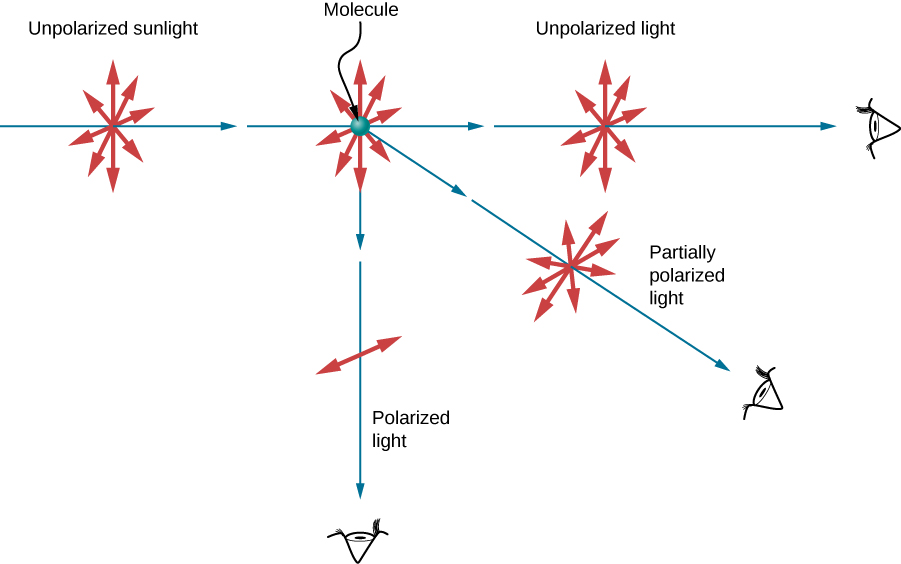| << Chapter < Page | Chapter >> Page > |

If you hold your polarizing sunglasses in front of you and rotate them while looking at blue sky, you will see the sky get bright and dim. This is a clear indication that light scattered by air is partially polarized. [link] helps illustrate how this happens. Since light is a transverse EM wave, it vibrates the electrons of air molecules perpendicular to the direction that it is traveling. The electrons then radiate like small antennae. Since they are oscillating perpendicular to the direction of the light ray, they produce EM radiation that is polarized perpendicular to the direction of the ray. When viewing the light along a line perpendicular to the original ray, as in the figure, there can be no polarization in the scattered light parallel to the original ray, because that would require the original ray to be a longitudinal wave. Along other directions, a component of the other polarization can be projected along the line of sight, and the scattered light is only partially polarized. Furthermore, multiple scattering can bring light to your eyes from other directions and can contain different polarizations.

Photographs of the sky can be darkened by polarizing filters, a trick used by many photographers to make clouds brighter by contrast. Scattering from other particles, such as smoke or dust, can also polarize light. Detecting polarization in scattered EM waves can be a useful analytical tool in determining the scattering source.
A range of optical effects are used in sunglasses. Besides being polarizing, sunglasses may have colored pigments embedded in them, whereas others use either a nonreflective or reflective coating. A recent development is photochromic lenses, which darken in the sunlight and become clear indoors. Photochromic lenses are embedded with organic microcrystalline molecules that change their properties when exposed to UV in sunlight, but become clear in artificial lighting with no UV.
Although you are undoubtedly aware of liquid crystal displays (LCDs) found in watches, calculators, computer screens, cellphones, flat screen televisions, and many other places, you may not be aware that they are based on polarization. Liquid crystals are so named because their molecules can be aligned even though they are in a liquid. Liquid crystals have the property that they can rotate the polarization of light passing through them by . Furthermore, this property can be turned off by the application of a voltage, as illustrated in [link] . It is possible to manipulate this characteristic quickly and in small, well-defined regions to create the contrast patterns we see in so many LCD devices.

Notification Switch
Would you like to follow the 'University physics volume 3' conversation and receive update notifications?